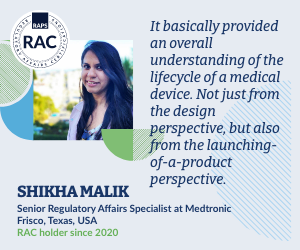FDA adds microbiological assessments to ophthalmic drug quality guidance
![]() Regulatory News | 03 January 2024 |
Regulatory News | 03 January 2024 |
The US Food and Drug Administration (FDA) recently issued a revised draft guidance for topical ophthalmic drugs recommending that manufacturers follow certain microbial testing guidelines to ensure that products remain sterile throughout the drug’s shelf life. This action responds to consumer injuries and deaths from microbially contaminated ophthalmic drug products as well as recent recalls. The scope of the guidance has also been expanded to include topical ophthalmics made at outsourcing facilities.
The guidance discusses quality considerations for ophthalmic gels, ointments, creams, and liquid formulations intended for topical delivery in and around the eye, and replaces a draft issued in October 2023. (RELATED: FDA issues guidance on assessing quality of topical ophthalmic drugs, Regulatory Focus 16 October 2023)
FDA is also revising the draft guidance to clarify that drugs compounded by outsourcing facilities under section 503B of the Federal Food, Drug, and Cosmetic (FD&C) Act are covered by the guidance. The document already covered new drug applications (NDAs), abbreviated new drug applications (ANDAs), biologics license applications (BLAs) and over-the-counter monograph drugs.
The guidance adds microbiological studies to the battery of tests manufacturers should perform to assess the quality of topical ophthalmics. The other tests include visible particle studies, extractables and leachable studies, container closure system studies, as well as studies to assess impurities and degradation products.
New section on microbial testing
FDA said the new section on microbial testing was added to address “several recent recalls of ophthalmic drug products and instances of consumer injury and death from microbiologically contaminated ophthalmic drug products.” The agency said these cases “highlight the importance of product sterility.”
The guidance was issued after a 14 November warning letter to India-based Global Pharma Healthcare for manufacturing eye drops that have been linked to an outbreak of bacterial infections resulting in consumer injury, blindness and at least three deaths. (RELATED: FDA: Global Pharma’s eye drops contaminated with “filth” while Amazon made unapproved claims for eye drops, Regulatory Focus 17 November 2023)
In a related development, Kilitch Healthcare India Limited announced on 16 November a voluntary nationwide recall of 26 OTC lubricant eye drops for safety reasons. FDA announced that “there is a potential risk of eye infections or related harm for consumers who use their products.”
Pay attention to preservatives
The guidance notes that unit-dose container closure systems (CCS) can ensure better sterility and prevent contamination and growth of microorganisms than multidose CCSs that are opened multiple times during the drug’s shelf life.
If multidose containers are used to package liquid ophthalmics, manufacturers should ensure that containers include “suitable substances” that will preserve the product and minimize contamination risks.
Such preservatives are necessary to guard against contamination following “potential microbial ingress.” This ingress can occur if surrounding air is introduced into the multidose container following product administration, or if the tip of a dropper is contaminated by a nonsterile surface.
The guidance states that “regardless of whether a multidose drug product possesses inherent antimicrobial activity or contains one or more added preservatives, manufacturers should implement a well-designed and rigorous antimicrobial effectiveness testing program that covers the product’s shelf life.”
FDA warns manufacturers against using preservatives that contain silver sulfate or other silver-containing compounds due to “significant” safety concerns associated with administering silver directly to the eye, resulting in argyria, or an irreversible discoloration of the skin and eyes.
Some manufacturers have opted to use a preservative-free formulation for a multidose container; the container has design features intended to prevent microbial contamination. Yet such these containers should be used with caution. The guidance states that “there are numerous ways in which such presentations might fail to prevent microbial contamination. Any ophthalmic drug product that lacks adequate preservative properties, when exposed to in-use contamination, is especially vulnerable to proliferation of microbes that can pose severe harm to consumers.”
Stakeholders have until 26 February to comment on the guidance. Comments can be submitted to docket FDA-2023-D-4177. FDA said that comments should address the new additions to the guidance.
Draft guidance, Announcement
The guidance discusses quality considerations for ophthalmic gels, ointments, creams, and liquid formulations intended for topical delivery in and around the eye, and replaces a draft issued in October 2023. (RELATED: FDA issues guidance on assessing quality of topical ophthalmic drugs, Regulatory Focus 16 October 2023)
FDA is also revising the draft guidance to clarify that drugs compounded by outsourcing facilities under section 503B of the Federal Food, Drug, and Cosmetic (FD&C) Act are covered by the guidance. The document already covered new drug applications (NDAs), abbreviated new drug applications (ANDAs), biologics license applications (BLAs) and over-the-counter monograph drugs.
The guidance adds microbiological studies to the battery of tests manufacturers should perform to assess the quality of topical ophthalmics. The other tests include visible particle studies, extractables and leachable studies, container closure system studies, as well as studies to assess impurities and degradation products.
New section on microbial testing
FDA said the new section on microbial testing was added to address “several recent recalls of ophthalmic drug products and instances of consumer injury and death from microbiologically contaminated ophthalmic drug products.” The agency said these cases “highlight the importance of product sterility.”
The guidance was issued after a 14 November warning letter to India-based Global Pharma Healthcare for manufacturing eye drops that have been linked to an outbreak of bacterial infections resulting in consumer injury, blindness and at least three deaths. (RELATED: FDA: Global Pharma’s eye drops contaminated with “filth” while Amazon made unapproved claims for eye drops, Regulatory Focus 17 November 2023)
In a related development, Kilitch Healthcare India Limited announced on 16 November a voluntary nationwide recall of 26 OTC lubricant eye drops for safety reasons. FDA announced that “there is a potential risk of eye infections or related harm for consumers who use their products.”
Pay attention to preservatives
The guidance notes that unit-dose container closure systems (CCS) can ensure better sterility and prevent contamination and growth of microorganisms than multidose CCSs that are opened multiple times during the drug’s shelf life.
If multidose containers are used to package liquid ophthalmics, manufacturers should ensure that containers include “suitable substances” that will preserve the product and minimize contamination risks.
Such preservatives are necessary to guard against contamination following “potential microbial ingress.” This ingress can occur if surrounding air is introduced into the multidose container following product administration, or if the tip of a dropper is contaminated by a nonsterile surface.
The guidance states that “regardless of whether a multidose drug product possesses inherent antimicrobial activity or contains one or more added preservatives, manufacturers should implement a well-designed and rigorous antimicrobial effectiveness testing program that covers the product’s shelf life.”
FDA warns manufacturers against using preservatives that contain silver sulfate or other silver-containing compounds due to “significant” safety concerns associated with administering silver directly to the eye, resulting in argyria, or an irreversible discoloration of the skin and eyes.
Some manufacturers have opted to use a preservative-free formulation for a multidose container; the container has design features intended to prevent microbial contamination. Yet such these containers should be used with caution. The guidance states that “there are numerous ways in which such presentations might fail to prevent microbial contamination. Any ophthalmic drug product that lacks adequate preservative properties, when exposed to in-use contamination, is especially vulnerable to proliferation of microbes that can pose severe harm to consumers.”
Stakeholders have until 26 February to comment on the guidance. Comments can be submitted to docket FDA-2023-D-4177. FDA said that comments should address the new additions to the guidance.
Draft guidance, Announcement
© 2025 Regulatory Affairs Professionals Society.













